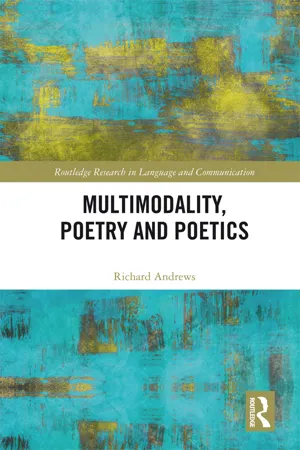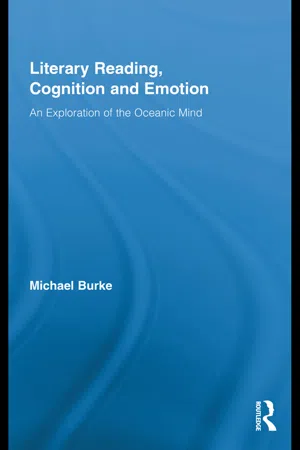Imagery
Imagery in literature refers to the use of descriptive language to create vivid mental images for the reader. It involves the use of sensory details such as sight, sound, taste, touch, and smell to evoke a sensory experience and enhance the reader's understanding and emotional connection to the text. Imagery can help to bring a story or poem to life by appealing to the reader's imagination.
6 Key excerpts on "Imagery"
- Tremper Longman III and Peter Enns, Tremper Longman III(Authors)
- 2020(Publication Date)
- IVP(Publisher)
...Imagery in Texts. To review adequately the study of Imagery in texts would take volumes because Imagery, as another term for figurative language, includes numerous devices such as metaphor, simile, allegory, *personification, apostrophe and a host of other figures of speech, not to mention still other topics (see Watson 2000, 270-73; J. Black, 51; Mitchell 1993b, 556). Since articles on specific images found in the OT appear elsewhere in this dictionary, this section treats three issues: (1) the importance of Imagery, (2) how images work, and (3) interpreting Imagery. Before we proceed further, a working definition of image/Imagery is in order. As Mitchell (1993b, 556-59) has noted, the terms image and Imagery historically have been used in a wide variety of ways (cf. Friedman). Even so, a usable point of reference is provided by L. Ryken, J. Wilhoit and T. Longman (xiii) in a recent dictionary devoted to biblical Imagery: “An image is any word that names a concrete thing (such as tree or house) or action (such as running or threshing). Any object or action that we can picture is an image.” This definition treats the image as a “verbal representation of a concrete (usually visual) object”; in this view, Imagery is “seen as eliciting mental images in the reader, evoking a kind of secondary visual representation” (Mitchell 1993a, 553). Though other understandings of image/Imagery are available, this “pictorial” or “visual” one is common (see Turco, 55; Oliver, 99; Watson 2001, 251). It should also be noted that Ryken, Wilhoit and Longman’s definition already indicates that Imagery is both “a mode of apprehension” and “a rhetorical device” (Mitchell 1993b, 557; cf. Oliver, 107; Watson 2001, 255); furthermore, it combines elements of text (naming, describing) and art (image, picturing). 1.1. The Importance of Imagery to Poetics. Poetry traffics in images. They are “the glory, perhaps the essence of poetry” (Alonso Schökel, 95; cf...
- eBook - ePub
- Richard Andrews(Author)
- 2018(Publication Date)
- Routledge(Publisher)
...4 Imagery in Poetry Implicit and Explicit Introduction Imagery in poetry and poetics is a well-trodden field. This is the level of figurative language—of metaphor, symbol, simile and metonymy—that is, fundamental not only to poetry but also to some kinds of prose and to other kinds of written language. Nevertheless, there is a level of signification in poetry that operates above that of the literal—or alongside it. Poetry seems to use Imagery (the default mode is the visual) to evoke imaginative spaces and to add dimension to literal description. The chapter draws on existing literature on figurative language, but it also breaks new ground in that it explores how and why images are invoked through the spoken and written word, and how they are deployed by both writer and reader (rhetor and audience) to generate new meaning. In addition, the chapter considers the classical notion of ut pictura poeisis and explores the function of Imagery in fugue. Poetic Language Bruns (1974) explores modern poetry and the idea of language, looking at the keystone role that poetic language has. At the heart of this exploration is the distinction between spoken and written poetic language. Spoken language is more obviously multimodal: it involves gesture, movement and sound, as well as the physical embodiment of the voice, and is more highly contextualized. There is a more obvious dialogism in spoken communication. Sub-sections of the spoken voice, such as tone and rhythm, are more readily identified, and spoken poetic language is more akin to music and especially song. But it was “the older grammatical tradition [in Rhetoric, that] took for its object not spoken but written (and most often, literary) language, and as a consequence tended to regard human speech as a wholly spatial and visual affair” (1974: 14)...
- eBook - ePub
Dramatic Adventures in Rhetoric
A Guide for Actors, Directors and Playwrights
- Giles Taylor, Philip Wilson(Authors)
- 2015(Publication Date)
- Oberon Books(Publisher)
...Chapter 3 Imagery CHASUBLE : Were I fortunate enough to be Miss Prism’s pupil, I would hang upon her lips. I spoke metaphorically. My metaphor was drawn from bees. Oscar Wilde, The Importance of Being Earnest (1895) The word ‘Imagery’ has the same Latin root (imago, image or representation) as the word ‘imagine’, of course, and imagination is perhaps the foremost quality of those of us that work in the theatre. Our role – whether as actor, playwright or director – is to appeal to the collective imagination of the audience in order to tell our stories. When language is used skillfully to describe mental or sensuous images, it enriches the experience immeasurably. Consider Lord Darlington’s famous assertion in Oscar Wilde’s Lady Windermere’s Fan (1892) that ‘We are all in the gutter, but some of us are looking at the stars’; it is a glorious, witty and thought-provoking image that instantly ignites our imaginative fires. Imagery must appeal to one or more of our senses. Look at the following example, in which John – the son of the play’s title – dreams of a future away from his loathed upbringing in a brutal industrialist family: JOHN : When I make a few thousands out of this little idea of mine I’m going to have everything I want, and forget all about the dirt and the ugliness, the clatter and bang of the machinery, the sickening hot smell of the furnaces – all the things I’ve hated from my soul. Githa Sowerby, Rutherford and Son (1912) By describing the world he wants to leave behind, he directly appeals to our senses of sight, hearing and smell. We are asked to invest in the filth, noise and stink of his surroundings, and are therefore drawn in to the character and the world he inhabits...
- eBook - ePub
Literary Reading, Cognition and Emotion
An Exploration of the Oceanic Mind
- Michael Burke(Author)
- 2010(Publication Date)
- Routledge(Publisher)
...As stated this was an opening (filler) question to see whether the subjects considered themselves avid readers. It seems I was dealing with readers who perceived themselves as such, irrespective of how they defined it. Question 2: When You Read Literature Do You Experience Mental Imagery? All eighteen subjects responded affirmatively. Nine opted to add a comment. 1. Especially descriptions of setting become vivid 2. In the sense that I sort of imagine what the people look like or where they are. Not incredibly detailed though 3. When I don’t I think it is a bad book. Also when I reread a book without knowing I’ve read it before the mental Imagery will be familiar where I have forgotten the storyline, title or characters 4. It is more Imagery like a feeling of faces and surroundings 5. Very strongly especially when it’s good writing 6. I frequently have intense mental images with literary works. Quite often I find the dialogue provokes the most images for me, scenery and the like usually don’t give a vivid image 7. Descriptions that I read become “pictures” 8. However, it often happens that it is an image very distantly related to the story, so it’s often based on one expression (word) 9. I think I automatically do. Literature is more than words. Right? Mental Imagery is an essential part of the connection a reader makes with a text, I think Interestingly, it can be seen from the responses that there seemed to be a split at this stage as to whether this Imagery was indistinct or vivid. Indistinct claims included responses 2, 4 and 6 and were best represented by the observations “in the sense that I sort of imagine what the people look like or where they are. Not incredibly detailed though” and also “it is more Imagery like a feeling of faces and surroundings”. This second response expresses distinct emotive and somatic aspects of perception in LRI...
- eBook - ePub
- Murray Knowles, Rosamund Moon(Authors)
- 2004(Publication Date)
- Routledge(Publisher)
...8 LITERARY METAPHOR Most of us probably made our first conscious acquaintance with metaphorical language in the study of literary texts: novels, drama, poetry, and so on. Language is ‘made strange’ in some way or foregrounded, so that it is different from other everyday usages although, as Kövecses (2002: 44) points out, creative writers very often base their work on the same conceptual metaphors that we all use in day-to-day existence. Notwithstanding this fact, creative metaphor is an essential literary ingredient. In Chapter 1, we pointed out that the term metaphor applies to several different linguistic phenomena, and we looked at some of the different types of non-literal language of which metaphor is the best-known form. We will now consider the most important of these which constitute the creative devices available to writers of literary text. As we do so, it is useful to remember that metaphorical language is, to varying degrees, ambiguous, and we will look at ambiguity itself later in this chapter. READING BETWEEN THE LINES As we have seen throughout this book, our understanding of metaphorical language depends not only on our linguistic competence but our cultural sensitivity, and our knowledge of more than just the surface structure of the words on the page. It is all very well for Humpty Dumpty to claim that when he uses a word, ‘it means just what I choose it to mean — neither more nor less’ (see Carroll Through the Looking Glass 1871/1970: 269), but meaning must have some form of general agreement among language users if meaningful communication is to take place. Nowhere is this truer than in the decoding of literary texts...
- eBook - ePub
- Wolfgang Clemen(Author)
- 2013(Publication Date)
- Routledge(Publisher)
...2 Imagery In The History Of Shakespeare Criticism DOI: 10.4324/9780203708477-2 T HAT Shakespeare's Imagery has had to wait long for the attention and consideration it deserves is no matter of mere chance, but the result of a gradual process, in the course of which men have slowly learned to understand Shakespeare's work in all its different aspects. The generation of poets which followed almost immediately after Shakespeare, the “Metaphysical Poets”, still possessed a fine appreciation of the lavish employment of images in dramatic poetry. Perhaps these poets carried the possibilities of metaphor too far in their sophisticated conceits; their use of Imagery had a strong intellectual quality which, on the whole, is rarer in Shakespeare and less typical of him. 1 What was for Shakespeare the expression of a powerful and passionate feeling, often became in their hands a clever and subtle play of the mind. Consequently, a natural reaction followed in the more rationally disposed late seventeenth and eighteenth century. The lavish use of Imagery common to almost all Elizabethans was repudiated, and the qualities demanded of style were clarity, precision and restraint. This naturally led to a great restriction of the possibilities of metaphorical language. 1 For a full and competent discussion of the difference between Elizabethan and Metaphysical Imagery, confined, however, to non-dramatic poetry, see Rosemond Tuve, Elizabethan and Metaphysical Imagery, Chicago, 1947. Some excellent observations on the same subject may be found in F. P...





